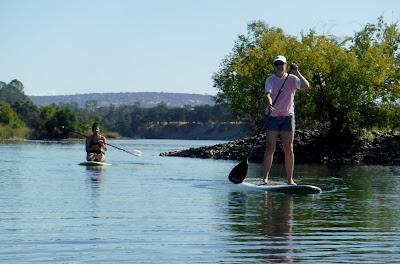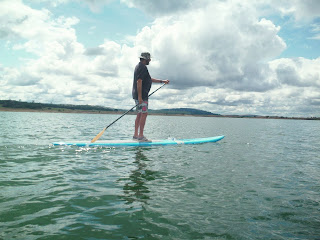The beach is busy and the lake is dotted with what seems like hundreds of stand up paddle boarders cruising along the shoreline. The boards are colorful, the paddles are long and sleek and the paddlers ever so graceful. It's a common scene this summer as the stand up paddling craze sweeps the US and Canada. An upright view of the water offers a refreshing escape from the summer heat. The only thing you need to join the stand up paddling revolution is a board, paddle and depending on your swimming ability a PFD to get started.
"Where are you going to paddle? For most paddle board shops, that would and should be the first question they ask you," explains Bayside Adventure Sports paddling coordinator, Brian Hughes, "Lake paddling is considered "flat-water" paddling which covers about half the boards in the marketplace. You would not want a board suited for surfing on waves."
While paddle boards come in different lengths, widths, thicknesses, and construction, they are all designed for either flat water or surf and sometimes a little of both. Here is an idea of type five basic boards at the paddle shop.
- Surf specific boards
- All-around/Touring boards
- Racing Boards
- Yoga Boards
- Inflatable stand up paddle boards
Surfing boards are narrower, shorter, lighter, and have a tapered nose and tail. They are designed for quick turns, high performance, and are used primarily in the ocean. They are also less stable than larger multipurpose boards that are wider, longer, have a greater volume. Their size and volume make them much more stable than wave boards.
"As a general guideline," says Hughes, "Wider boards are more stable. Narrower boards are what we call "tippy," meaning that while paddling, you feel like you could fall off at any second. Flat-water boards do not have as much rocker as ocean boards. The rocker is the slight curve that follows the bottom of the board. A board with a lot of rocker will have somewhat of a "banana" appearance, and when you set that board on the flat ground, the nose and tail will both be lifted off the ground. Flat-water boards don't need as much rocker."
The all-around touring boards are ideal for beginners trying out SUP boarding for the first time. A board with a wide tail is usually more stable. Beware of boards that have a roundness to the side to side contour of the bottom of the board. "Any roundness added to the bottom," says Hughes, "makes the board more tippy."
Racing boards designed for intense training are longer, narrower and have an extremely pointy nose and a very long fin. These boards are very unstable unless moving forward at a fast speed. Yoga boards are wider and longer than surfing boards. They have a soft top and places to hook up various exercise tools like resistance bands and safety equipment. It is also good to have an anchor so they don’t drift away during a mid-lake workout.
If storage and transportation is a problem, consider inflatables paddle boards which are lighter and easier to transport in the trunk of any car. However, making wave riding a challenge, they are not as stiff as a regular board. "They work," says Hughes, "but can feel "bouncy" if not inflated properly, and they don't make a high-performance inflatable board."
Newer paddlers should first choose a board with more volume until they get used to the sport. The more volume a board has the more stable it will be out on the water. A paddler's height and weight
are important dynamics in paddling the board. "It is a function of the weight of rider as contrasted with the size of the board, " said Hughes, "A 250 lb. person is not going to be able to ride a nine-foot longboard. They need a twelve-foot board or longer. By the same token, a 110 lb person is going to have a hard time riding a twelve foot board, and will be much better off on a nine to ten foot board."
Below is a chart of Eastern Mountain Sports recommended weight ranges.
Beginner Advanced
Beginner Advanced
| Beginner-Advanced Length: 10 ft. 6 in.-11 ft. Width: 28-30 in. |
Weight: 120-150 lb. Length: 9 ft.-10 ft. 6 in Width: 26-26.5 in. |
| Weight: 160-190 lb.. Length: 11 ft. Width: 29-32 in. |
Weight: 160-190 lb. Length: 9 ft. 6 in.-10 ft. 6 in. Width: 27-28 in. |
| Weight: 200-230 lb. Length: 11 ft.-11 ft. 6 in. Width: 29-32 in. |
Weight: 200-230 lb. Length: 10 ft.-11 ft. Width: 28-28.5 in. |
| Weight: 240-270 lb. Length: 11 ft. 6 in.-12 ft. Width: 32-33 in. |
Weight: 240-270 lb. Length: 11 ft.-11 ft. 6 in. Width: 29.5-31.5 in. |
| Weight: 280+ lb. Length: 12 ft. Width: 33 in. |
Weight: 280+ lb. Length: 12 ft. Width: 32 in. |
The SUPs come with one, two, or three fins and sometimes even four or five. The fins keep the board going straight. On flat water, a single fin works well. Fins are made of either fiberglass or nylon. The more fins a board has, the more specialized it is. Fiberglass fins provide the best performance, but they’re stiff and sharp and can be a danger if not careful. It’s also common to snap a fiberglass fin in very shallow water or on the rocks.
"Let the person who rents the board be your guide," said Hughes, "The first time out, you are not looking for performance characteristics. You are looking to have a sufficient board underneath to have a pleasant experience. Once you have paddled a few times, and are thinking of purchasing a board, the best strategy is to go to a "demo day" and try a bunch of boards."
Stand up paddle boarding is an easy way to enjoy the great outdoors, get some exercise, and have fun. It’s also a great way to give your body a full workout. Whether the ocean or the serenity of a quiet lake, the board will offer a great time on the water.







































